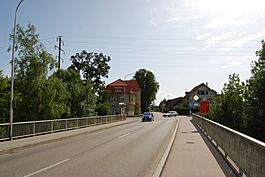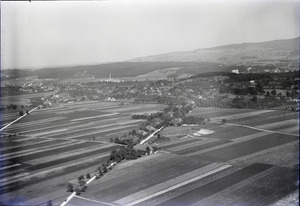Bargen, Bern facts for kids
Quick facts for kids
Bargen
|
||
|---|---|---|
 |
||
|
||
| Country | Switzerland | |
| Canton | Bern | |
| District | Seeland | |
| Area | ||
| • Total | 7.86 km2 (3.03 sq mi) | |
| Elevation | 448 m (1,470 ft) | |
| Population
(Dec 2020 )
|
||
| • Total | 1,051 | |
| • Density | 133.72/km2 (346.3/sq mi) | |
| Postal code |
3282
|
|
| Surrounded by | Niederried bei Kallnach, Kallnach, Siselen, Walperswil, Kappelen, Aarberg, Radelfingen. | |
Bargen is a small town, also called a municipality, located in the Seeland area of Switzerland. It is part of the canton of Bern.
Contents
Discovering Bargen's Past
Bargen was first written about in the year 1228. But people lived here much earlier!
Ancient History of Bargen
- Stone Age and Bronze Age Life: The oldest signs of people living in Bargen are tools and items from the Bronze Age. These were found in a place called Bargenfeld. Even older items from the Neolithic (New Stone Age) and Hallstatt periods have been discovered.
- Roman Road: Bargen is located on an old Roman road. This road connected the Roman cities of Aventicum and Petinesca. You can still see parts of this ancient road today.
- Medieval Times: There are also old ruins from the Middle Ages. These ruins might be from a boat dock and bridge that belonged to a cluniac priory (a type of monastery).
Bargen's Fortifications and Control
In 1831-1832, people built defenses in the village. These were made to protect the important crossing point over the Aare river. Bargen used to be part of the Herrschaft (a type of territory) of Aarberg. In 1375, Bargen, along with Aarberg, came under the control of Bern.
The Village Church of St. Mary
The village church, called St Mary, was first mentioned in 1228. It was built in a mix of Romanesque and Gothic styles. In the 14th century, powerful lords from La Roche looked after the church. Later, in 1415, it was managed by Frienisberg Abbey. In 1528, the church became owned by Bern. It was updated and changed in 1671-1672.
Farming and Canals
Bargen's economy has always relied a lot on farming around the Aare river. Several canals were built over the years to help with farming and change the landscape:
- Aarberger Ship Canal: Built between 1645 and 1663.
- Hagneck Canal: Built from 1868 to 1878.
- Kallnach Power Station Canal: Built between 1909 and 1912.
These canals helped create more land for farming. Even in 1990, more than a third of the jobs in Bargen were still in agriculture.
Bargen's Location and Landscape
Bargen is located in a very flat and fertile area called Grossen Moos, within the Seeland region.
Neighboring Towns and Rivers
Bargen is surrounded by several other towns. These include Niederried bei Kallnach, Kallnach, Siselen, Walperswil, Kappelen, Aarberg, and Radelfingen. The border with Radelfingen is marked by the Aar river, which flows into the Rhine. To the north, Bargen is bordered by the Aare-Hagneck canal. Bargen itself is a linear village, meaning it stretches out along a main road.
Land Use in Bargen
Bargen covers an area of about 7.86 square kilometers (3.03 square miles).
- Farmland: About 70.6% of Bargen's land is used for farming. This includes fields for crops, pastures for animals, and some orchards.
- Forests: Around 18.7% of the area is covered by forests.
- Buildings and Roads: About 7.0% of the land is used for buildings and roads.
- Water: The remaining 3.9% is made up of rivers and lakes. All the water in the municipality is flowing water.
Bargen's Coat of Arms
The blazon (description) of Bargen's coat of arms is: Gules a Pegasus rampant Argent. This means it shows a silver Pegasus (a mythical winged horse) on a red background.
People of Bargen
Bargen has a population of about 980 people (as of 2010).
Population Changes
Over the ten years from 2000 to 2010, Bargen's population grew by about 7.8%. Most of this growth was due to people moving into the town.
Languages Spoken
As of 2000, most people in Bargen (about 95.3%) speak German as their main language. Other languages spoken include Serbo-Croatian and Portuguese. A few people also speak French, Italian, or Romansh.
Where People Come From
In 2000, about 36.3% of Bargen's residents were born there. Another 43.8% were born in the same canton (Bern). About 9.7% were born elsewhere in Switzerland, and 7.4% were born outside of Switzerland.
Age Groups
As of 2000, the population of Bargen was divided into these age groups:
- Children and Teenagers: (0–19 years old) make up about 29.3% of the population.
- Adults: (20–64 years old) make up about 53.9% of the population.
- Seniors: (over 64 years old) make up about 16.8% of the population.
Family Life
In 2000, there were 342 private homes in Bargen, with an average of 2.6 people living in each home. Most apartments (94%) were lived in all the time.
Bargen's Economy
Bargen is close to bigger villages, so it doesn't have large department stores. However, it does have local businesses.
Local Businesses
You can find a butcher's shop, a pizza delivery service, three restaurants, and a small brewery in Bargen.
Jobs in Bargen
As of 2008, Bargen had jobs in different areas:
- Primary Sector: About 85 people worked in the primary sector, which mainly involves agriculture (farming). There were about 30 businesses in this sector.
- Secondary Sector: About 254 people worked in the secondary sector. This includes manufacturing (making things) and construction (building things). There were 7 businesses in this sector.
- Tertiary Sector: About 89 people worked in the tertiary sector, which provides services. There were 17 businesses in this sector. This includes jobs in sales, restaurants, education, and healthcare.
Commuting to Work
In 2000, about 100 workers came into Bargen for their jobs, while 350 workers left Bargen to work elsewhere. This means more people from Bargen work outside the town than inside it. Most people (51.9%) used a private car to get to work, while 12.6% used public transportation.
Religion in Bargen
Based on the 2000 census:
- About 81.2% of the people belonged to the Swiss Reformed Church (a Protestant church).
- About 8.0% were Roman Catholic.
- A smaller number belonged to other Christian churches or were Islamic.
- Some people did not belong to any church or preferred not to answer.
Education in Bargen
Education in Bargen follows the system of the Canton of Bern.
School System
- Kindergarten: One year of non-required kindergarten.
- Primary School: Six years of primary school.
- Lower Secondary School: Three years of required lower secondary school. Students are grouped by their abilities.
- After Secondary School: After lower secondary, students can continue their education or start an apprenticeship (learning a trade on the job).
Students in Bargen
During the 2009-2010 school year, 88 students attended classes in Bargen.
- There was one kindergarten class with 25 students.
- There were three primary classes with 48 students.
- There was one lower secondary class with 15 students.
Some students were from other countries or had a different first language than the classroom language. In 2000, 61 students from Bargen went to schools outside the municipality.
Getting Around Bargen
Bargen is connected by both road and rail.
Train Station
Bargen has its own railway station on the Palézieux–Lyss line.
Main Road
The village itself stretches along the main road that connects Aarberg to Kerzers.
Images for kids
See also
 In Spanish: Bargen (Berna) para niños
In Spanish: Bargen (Berna) para niños







